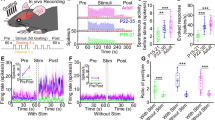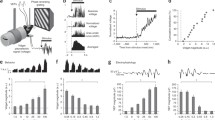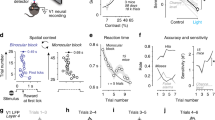Abstract
The effects of perfusion of field 17 with the glutamate receptor antagonist 2-amino-5-phosphonovaleric acid (APV) on the characteristics of visual recognition and short-term memory were studied, along with the effects of APV on the responses of neurons in the visual and prefrontal areas of the cortex in rhesus macaques. In the test for delayed visual differentiation of stimuli of different colors, behavioral data were recorded simultaneously with multichannel recordings of the spike activity of single cells in cortical field 17 (directly within the microdialysis zone) and field 8. Multifactor dispersion analysis (ANOVA) showed that APV significantly worsened the behavioral characteristics in monkeys, with significant reductions in the duration of short-term storage of information (by factors of 2–4) and significant increases in the motor response times. These changes in cognitive characteristics induced by APV were accompanied by changes in the spike activity of neurons in the visual and prefrontal areas of the cortex during the sensory analysis and delay stages; changes in spike activity consisted of significant desynchronization. These results show that cognitive dysfunctions consisting of worsening of short-term remembering of information and increases in the duration of motor responses during exposure to APV may be caused by desynchronization of neuron activity in various areas of the cortex, these being involved in neuron ensembles responsible for the mechanisms of short-term memory, in which glutamatergic structures play an important role.
Similar content being viewed by others
REFERENCES
A. S. Batuev, G. P. Dem'yanenko, A. A. Orlov, and V. I. Shefer, Neuronal Mechanisms of the Conscious Brain in Monkeys [in Russian], Nauka, Leningrad (1986).
S. A. Dambinova, Glutamate Neuroreceptors [in Russian], Nauka, Leningrad (1989).
K. N. Dudkin, Visual Perception and Memory [in Russian], Nauka, Leningrad (1985).
K. N. Dudkin, V. K. Kruchinin, Yu. V. Skryminskii, and I. V. Chueva, Methods for the Automated Study of the Neuronal Mechanisms of Behavior [in Russian], Nauka, Leningrad (1989).
K. N. Dudkin, V. K. Kruchinin, and I. V. Chueva, “Processes of visual recognition in monkeys and their neurological correlates in the visual cortex: the effects of an m-cholinoreceptor blocker,” Ros. Fiziol. Zh. im. I. M. Sechenova, 78, No. 10, 36–43 (1992).
K. N. Dudkin, V. K. Kruchinin, I. V. Chueva, M. O. Samoilov, and I. V. Lazarevich, “A method for the microdialysis of the cerebral cortex in studies of the neurophysiological correlates of recognition processes in monkeys,” Ros. Fiziol. Zh. im. I. M. Sechenova, 80, No. 10, 128–132 (1994).
K. N. Dudkin, V. K. Kruchinin, and I. V. Chueva, “The activity of glutamatergic structures in the visual cortex during the effects of NMDA on delayed visual differentiation in monkeys,” Ros. Fiziol. Zh. im. I. M. Sechenova, 81, No. 5, 23–30 (1995).
K. N. Dudkin, V. K. Kruchinin, and I. V. Chueva, “Synchronization processes in the mechanisms of short-term memory in monkeys: involvement of cholinergic and glutamatergic cortical structures,” Ros. Fiziol. Zh. im. I. M. Sechenova, 81, No. 8, 128–134 (1995).
N. A. Emel'yanov and M. O. Samoilov, “Molecular-cellular mechanisms of long-term potentiation,” Usp. Fiziol. Nauk., 27, No. 3, 12–30 (1996).
S. N. Olevev, Construction of the Brain [in Russian], Nauka, Leningrad (1987).
M. O. Samoilov, N. A. Emel'yanov, V. P. Nikitin, and A. A. Mokrushin, “The current state in studies of the molecular-cellular mechanisms of learning,” Ros. Fiziol. Zh. im. I. M. Sechenova, 79, No. 5, 89–97 (1993).
V. M. Storozhuk, S. F. Ivanova, and A. V. Sanzharovskii, “Involvement of glutamate intracortical connections in conditioned reflex activity,” Neirofiziologiya, 24, No. 6, 701–712 (1992).
T. V. P. Bliss and G. L. Collingridge, “A synaptic model of memory: long-term potentiation in the hippocampus,” Nature, 361, 31–39 (1993).
E. D. Cohen and R. F. Miller, “The role of NMDA and non-NMDA excitatory amino acid receptors in the functional organization of primate retinal ganglion cells,” Visual Neuroscience, 11, 317–332 (1994).
H. R. Friedman and P. S. Goldman-Rakic, “Coactivation of prefrontal cortex and inferior parietal cortex in working memory task revealed by 2DG functional mapping in the rhesus monkey,” J. Neurosci., 14, No. 5, 2775–2788 (1994).
G. W. Huntley, J. C. Vickers, W. Janssen, N. Brose, S. H. Heinemann, and J. H. Morrison, “Distribution and synaptic localization of immuncytochemically identified NMDA receptor subunit proteins in sensory-motor and visual cortices of monkey and human,” J. Neurosci., 14, 3603–3619 (1994).
J. Quintana and J. M. Fuster, “Spatial and temporal factors in the role of prefrontal and parietal cortex in visuomotor integration,” Cereb. Cortex, 3, 122–132 (1993).
C. E. Rosenkilde, “Functions of the prefrontal cortex,” Acta Physiol. Scand. Suppl., 514, 1–58 (1983).
R. Scherzer, B. Landwehrmeyer, J. A. Kerner, T. J. Counihan, C. M. Kosinski, D. G. Standaert, L. P. Daggett, G. Velicelebi, J. B. Penney, and B. Anne, “Young expression of N-methyl-D-aspartate receptor subunit mRNAs in the human brain: hippocampus and cortex,” J. Comp. Neurol., 390, 75–90 (1998).
Z. Y. Tong, P. G. Overton, C. Martinez-Cue, and D. Clark, “Do non-dopaminergic neurons in the ventral tegmental area play a role in the responses elicited in A10 dopaminergic neurons by electrical stimulation of the prefrontal cortex?” Exp. Brain Res., 118, No. 4, 466–476 (1998).
A. Ungerer, C. Mathis, and C. Melan, “Are glutamate receptors specifically implicated in some forms of memory processes?” Exp. Brain Res., 123, No. 2, 45–51 (1998).
Author information
Authors and Affiliations
Rights and permissions
About this article
Cite this article
Dudkin, K.N., Kruchinin, V.K. & Chueva, I.V. The Effects of an NMDA Receptor Antagonist on Delayed Visual Differentiation in Monkeys and Rearrangements of Neuron Spike Activity in the Visual and Prefrontal Areas of the Cortex. Neurosci Behav Physiol 31, 191–200 (2001). https://doi.org/10.1023/A:1005220509445
Issue Date:
DOI: https://doi.org/10.1023/A:1005220509445




